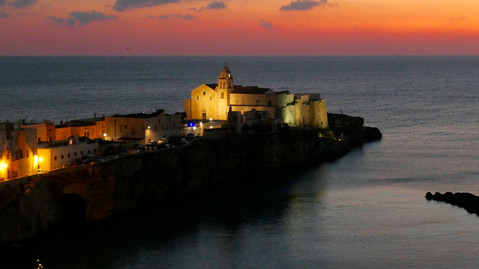

If you were to travel in a straight line from Naples to Dubrovnik you would come across Vieste in Puglia at the half way point just before getting your feet wet. And if that piece of geography trivia leaves you none the wiser as to Vieste's location, then let me describe it this way: if the whole of Italy is a boot with the region of Puglia as its heel then the Gargano peninsula jutting out into the Adriatic is the spur on the heel and Vieste is the spinning wheel at the end of the spur. Something like the photograph below.

As you will have guessed from that introduction, Vieste is in a strange isolated spot and not a particular convenient place to reach. Driving to Vieste doesn’t look all that daunting from the map but the roads are quite poor in places and full of twists and turns that inhibit progress.
Furthermore the entire peninsula is covered by the Gargano National Park and is a wild, remote place almost bereft of towns but for us it was the last stretch of the Adriatic coastline from Venice to Santa Maria di Leuca, at the southern tip of the heel, that we hadn't yet seen.

Vieste is a truly fascinating place that is both physically beautiful, with lots of whitewashed buildings set within an enveloping sea, and a real, vibrant town with a genuine southern Italian atmosphere. This was no surprise to us because we know Puglia very well and have loved it since our first trip here ten years ago.
The Pugliesi are warm friendly people and the entire region is dotted with interesting towns full of fascinating history and nowhere is very far from the coast. It gets the most sunshine in Italy and has the oldest olive trees, some of which are still going after more than 800 years.
The only thing missing for us in Puglia generally are hills because most of the region is as flat as Florida, but the Gargano presents a complete contrast. It has elevations up to 3,500 feet in the interior with ancient virgin forests of oak, maple, beech and pine. The coastline also does not disappoint, consisting of miles of eroded white limestone cliffs and little sandy beaches hiding here and there, often accessible only by boat.

Despite the hostile and forbidding aspect of the Gargano from the sea, it did not deter Ottoman invaders all through the 15th and 16th centuries and they were unfailingly brutal to Pugliesi christians.

Further south in Otranto there are still 800 martyrs' skulls stacked behind glass in the duomo as a somewhat ghoulish reminder of the wholesale executions in 1480 perpetrated by the Turks, and in Vieste itself the Chianca Amara (bitter rock) is a poignant memorial to the 7,000 local victims of Ottoman raiders in 1554.
Every Italian knows the famous phrase from history “mamma li turchi!” which was the cry of alarm and fear at the first sight of Turkish ships on the horizon. For centuries all across southern Italy this was yelled out in panic to warn everyone of the slaughter that was about to take place.
We arrived in Vieste from the north, stopping first at Vasto in Abruzzo and Termoli in Molise, both of which we will cover in a later article. After Termoli there is not much reason to stop until you get to Lago di Varano and then only if you are a fisherman or want to explore the six mile stretch of largely empty beaches separating the lagoon from the sea. Before reaching Vieste you then pass through the towns of Rodi Garganico and Peschici, nice enough places and convenient departure points for a day trip to the Tremiti Islands but both towns are very small.

Staying in the centro storico in Vieste presents one of those parking problems that we’ve described in the Experiencing Italy section here and there’s no getting away from the fact that there are also lots of steps to be negotiated just walking around Vieste. However the different elevations add immeasurably to the charm.
The centro storico is perched on top of the cliffs facing the open sea yet is seamlessly integrated with the newer part of town a little lower down. It’s full of shops and restaurants squeezed into nooks and crannies and newly arrived tourists wandering around looking completely lost. Everybody is the first day.

Every morning we walked the few minutes down Via Cesare Battisti to the bustle of the new town and the cafes around the small tropical park just off Corso Lorenzo Fazzini and next time we’ll stay in this area because it’s here, away from the centro storico, that you find the locals drinking coffee and chatting and regular Italian life in full flow.

The partly covered daily market is nearby, just a couple of hundred yards along the road, and if you’re staying in an apartment with a great view and want to eat in and enjoy the sunset one night then you’ll find all the local food and wine you need right here.
We did exactly that, but at lunchtime. At the very least buy some of the bite-sized Pugliese bread snacks called tarallo which are simple little things but somehow you can’t stop munching them and the typical southern cheese caciocavallo which goes with everything. And of course the choice of olives in Puglia is bewildering and none of them will remind you of olives you’ve ever had from a jar at home.

Vieste is a walking town and once you’ve got a feel for the place you’ll find there is often a longer way around if you want to avoid all the steps. The promontory below the centro storico is famous from a million photographs with the Chiesa di San Francesco at the end and all along the water in summer there are bars, restaurants and outdoor tables.
On the other side of town going south there are plenty of beaches within walking distance including the other most photographed image of Vieste, the limestone monolith called Pizzomunno which of course comes with its own legend.

There are even a couple of trabocchi below the cliffs. These are the old wooden fishing platforms that are famous further north in Abruzzo especially along what’s known as the Trabocchi Coast between Ortona and Vasto where they extend much further out into the sea and where many are now restaurants equipped with full kitchens and a haphazard arrangement of small private decks for one or two tables.

It makes for a very atmospheric dinner in summer to be completely surrounded by water with just netting between you and the sea and with the other diners barely visible in the gloom. But here in Vieste sadly the trabocchi are just wrecks.
The only reason to get back in the car during your stay in Vieste would be to visit the Foresta Umbra if a hike in the woods is your thing. A half-hour drive will get you to the trailheads but we opted for the boat excursion instead, mainly because we didn’t want to get back in the car until our departure day and we didn’t want to spend any time out of sight of the sea.
The boats leave from the large harbor just north of the town center, only a short walk away and we would recommend taking the “Desiree” boat coastal trip. It’s a bigger boat than those used for a similar trip in Palinuro in Campania, but it’s one of the smaller boats here and as the trip takes about three hours it's best to take the morning departure if it’s hot.

The boat takes you about 12 miles south along the coast for a good look at the spectacular white limestone cliffs and caves and then makes a stop at the Vignanotica Beach where you can have a swim, buy refreshments etc. One of the best things about taking any kind of boat trip in Vieste is the superb and very different views you get of Vieste itself from the sea and you begin to understand the attraction to Turkish invaders.

Puglia has 540 miles of coastline so it’s not surprising that there are a lot of traditional seafood dishes, those with mussels being the most common. But Puglia has always symbolized la cucina povera and its food traditions reflect its long history of relative poverty. Meat was rare and dairy almost non-existent so vegetables were often the main ingredient, hence the most famous dish that everyone in Italy associates with Puglia is orecchiette con cime di rapa.
Orecchiette translates as “little ears” because of the shape of the pasta and cime di rapa are the green tops of turnips known as broccoli rabe in the US. It’s a slightly bitter highly nutritious member of the cruciferous family of vegetables that also includes mustard greens. Ironically in the UK this simple dish appears only in fancy restaurants instead of as a cheap staple in kitchens at home as it is in Italy.
Cicoria is another classic Pugliese vegetable and is a form of Italian dandelion, even more bitter and perhaps more of an acquired taste. One thing that most of these dishes have in common if you want to experience them the traditional way is the absence of grated cheese at the end. Instead you will find breadcrumbs (home made of course) used instead because throughout history cheese was either unavailable or too expensive. But now it's fine to add some parmigiano because you don’t need to be a purist and restaurants will offer you grated parmigiano on everything these days except fish.
Orecchiette with cabbage and pancetta is another simple dish that I first learned about at the Awaiting Table cooking school in Lecce 10 years ago.

Our restaurant experience in Vieste was mostly excellent and the two places worthy of special mention are Osteria al Duomo, plumb in the middle of the centro storico and Bella Napoli, a short walk away towards the port. Two very different restaurants.
Osteria al Duomo is fine dining at its best with a creative and original menu and set in a refurbished centuries old dungeon for want of a better description. Great food, great atmosphere and a fair price despite being in the middle of a tourist area.
Bella Napoli is cheap local dining at its best. We would normally walk right by anything with such a clichéd name but often we pop inside places like this for a quick look at who’s eating in the restaurant and what accents we hear and if it’s mostly locals then it’s good enough for us. The mussels were excellent and the pizza was perfect, as it should be in the south. The first rule in these situations is not to order anything too complicated, eat simple dishes that the locals eat and the second rule is not to be a slave to tripadvisor ratings otherwise you’ll miss places like this.











